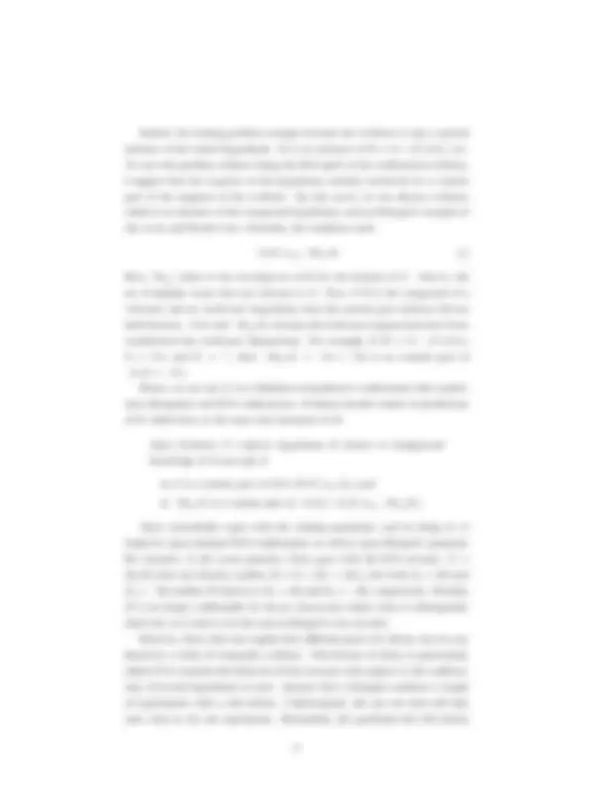










Study with the several resources on Docsity

Earn points by helping other students or get them with a premium plan


Prepare for your exams
Study with the several resources on Docsity

Earn points to download
Earn points by helping other students or get them with a premium plan
Community
Ask the community for help and clear up your study doubts
Discover the best universities in your country according to Docsity users
Free resources
Download our free guides on studying techniques, anxiety management strategies, and thesis advice from Docsity tutors
The synthesis of confirmation by instances and confirmation by successful predictions in the context of Hempelian and hypothetico-deductive traditions in confirmation theory. It critiques the shortcomings of both classical H-D account and Hempel's confirmation by instances, and proposes a synthetic account that circumvents their objections. The document also discusses the role of qualitative studies in supplementing quantitative confirmation theory.
What you will learn
Typology: Study notes
1 / 14

This page cannot be seen from the preview
Don't miss anything!









Abstract This paper synthesizes confirmation by instances and confirmation by successful predictions, and thereby the Hempelian and the hypothetico- deductive traditions in confirmation theory. The merger of these two approaches is subsequently extended to the piecemeal confirmation of en- tire theories. It is then argued that this synthetic account makes a useful contribution from both a historical and a systematic perspective.
There are two grand tradition in qualitative confirmation theory: hypothetico- deductive (H-D) confirmation and confirmation by instances, usually linked to the name of Carl G. Hempel. However, both the classical H-D account and Hempel’s confirmation by instances have severe shortcomings, as has been noted a number of times (Glymour 1980a,b; Gemes 1998). These problems were partly addressed by the efforts of Glymour (1980a), Schurz (1991) and Gemes (1993), but their resolutions of these difficulties came at the expense of simplicity and transparency. For instance, the perhaps best game in town (Gemes 1993) rela- tivizes the confirmation relation to the ‘natural axiomatization’ of a theory. Therefore, this paper has two principal aims: First, it is shown that the basic Hempelian and H-D intuitions can be synthesized into a single (albeit restric- tive) account, which may be regarded as the ‘core’ of qualitative confirmation. Notably, the logical formalism required for the synthesis is very parsimonious. The two traditions might thus be closer to each other than previously thought, in particular by Hempel himself. Second, it is shown that the synthetic account circumvents the standard objections to H-D and instance confirmation, gets the paradigmatic examples right and can be extended to the confirmation of entire theories. Thus, the synthesis is interesting from both a historical and a systematic perspective. The paper is structured as follows: Section 2 gives a brief motivation of qualitative confirmation theory vis-`a-vis quantitative approaches. Section 3 presents H-D and instance confirmation, as well as their problems. Section 4 introduces the principal technical tool of the paper – Ken Gemes’ content parts. Section 5 uses content parts to synthesize Hempelian and H-D confirmation, whereas Section 6 extends the definition to the confirmation of entire theories. Section 7 discusses the synthetic account and concludes.
As of today, purely qualitative, syntactic accounts of confirmation have largely been superseded by quantitative accounts such as Bayesianism. Therefore, I consider it necessary to devote some lines to motivating the pursuit of a quali- tative confirmation criterion. There is a popular prejudice that with the advent and success of Bayesianism, the study of the qualitative dimension of confirmation has become obsolete. Bayesians model the beliefs of scientists by means of probability functions, and explicate degree of confirmation as the credibility boost that a tested hypothesis
proof that the hypothesis was valuable and, at least to a great extent, true. (Whewell 1847, 62-63)
Modeling empirical support by successful (deductive) prediction is the bottom line of the hypothetico-deductive (H-D) model of confirmation. From the hypoth- esis under test and some auxiliary assumptions, we derive empirical predictions that confirm, if verified, the original hypothesis. For instance, a physicist will test the harmonic oscillator model captured by the equation ¨x + ω^2 x = 0 for swinging pendula by deriving its consequences for a particular pendulum. If the predictions of the oscillator model are verified, they confirm the harmonic oscillator model, if not, they refute it. Moreover, the H-D model resembles the ‘conjectures and refutations’-model of scientific progress (Popper 1934/71): hypotheses have to be subjected to severe tests in order to gain corroboration. This fact distinguishes it among all qualitative accounts of confirmation. It is thereby an attractive model for those who are reluctant to assign degrees of belief in the truth of a scientific hypothesis (a presumption of Bayesianism) but who believe that by subjecting a hypothesis to severe tests and failing to observe refutations, it can be corroborated and favored over others. H-D confirmation may be regarded as the non-probabilistic counterpart of those philosophies of inductive learning that emphasize severe testing of statistical hypotheses (e.g., Mayo 1996) vs. subjective belief updating. For these reasons, it still deserves the attention of philosophers of science.
Classical formulations of H-D confirmation such as
(H-D) Evidence E H-D confirms hypothesis H relative to back- ground knowledge K if and only if (1) H.K is consistent, (2) H.K entails E and (3) K alone does not entail E.
have several substantial shortcomings. First, we often want to say that the results of a scientific experiment do not only support an isolated hypothesis, but speak in favor of an entire theory consisting of several interrelated models or theories (e.g., Dietrich and Moretti 2005). (H-D) does not specify how entire theories, or major parts thereof, are confirmed, as opposed to the confirmation of single hypotheses. Second, (H-D) is unable to cope with the so-called tacking paradoxes. It is possible to tack irrelevant disjunctions to the evidence E and to preserve the confirmation relation: If E confirms a hypothesis H relative to K, E ∨ E′^ confirms the same H for an arbitrary E′, relative to K. So, the
predictions of the harmonic oscillator model about a swinging pendulum or the observation of a single black raven would confirm that swinging pendula are harmonic oscillators. This objection exploits the fact that any logical consequence of H, however partial it is, still counts as a prediction of H and thus confirms it. In other words, classical H-D confirmation gives no account of evidential relevance. A similar problem already troubled Hempel in his ‘Studies in the Logic of Confirmation’ (Hempel 1945/65). Hempel discusses various adequacy criteria for qualitative confirmation and also considers the
Converse Consequence Condition (CCC): If E confirms H and H′^ entails H, then E also confirms H′.
Taking the example E = H = ‘a is a raven’ and H′^ = ‘Hooke’s law holds and a is a raven’, Hempel observes first that E confirms H according to what he calls the Entailment Condition and concludes: ‘here, the rule that whatever confirms a given hypothesis also confirms any stronger hypothesis becomes an entirely absurd principle’ (Hempel 1945/65, 32–33). Formally, this is the flip side of the problem of irrelevant disjunctions: namely the possibility of tacking irrelevant conjunctions to the confirmed hypothesis H. That is, if E confirms H relative to K, then E also confirms H.X for any X such that H.X 6 |=E and {H, X, K} is a consistent set of propositions. Since CCC invites to such irrelevant conjunctions, Hempel rejects the prin- ciple and the associated hypothetico-deductive intuition in favor of a different account of confirmation that focuses on deriving instances of a hypothesis. This is the second grand tradition in confirmation theory. The idea goes back to Jean Nicod (1925) who modeled ‘l’induction par confirmation’ as the discovery of in- stances of a hypothesis under test (see also Glymour 1980a). Planet orbits are instances of Kepler’s laws. Swinging pendula instantiate the harmonic oscilla- tor. Black ravens instantiate the hypothesis that all ravens are black. Hempel (1943, 1945/65) provided the first rigorous formalization of this idea by demand- ing that the evidence entail the development of the hypothesis to the domain of the evidence. This is quite different from the H-D account where the deductive arrow goes from the hypothesis to the evidence. The core of Hempel’s formalization is captured by the satisfaction criterion: (Hempel) Evidence E (directly) Hempel-confirms hypothesis H rel- ative to background knowledge K if and only if E.K entails the development of H for E, that is, the restriction of H to the set of
The source of the problem of irrelevant disjunction is the property of first-order logic that well-formed forms (wffs) sometimes have irrelevant consequences: for instance, the conclusion in F a |= (F a ∨ Ga) contains the irrelevant element Ga. We need a logical relation different from standard deductive entailment in order to discern irrelevant disjuncts. For the sake of simplicity, I presup- pose a first order predicate language L without identity, but the extensions are straightforward.^3 Ken Gemes’ (1993) account of content parts achieves that goal by analyzing relevance relations between wffs. The following definition captures an intuitive view of relevance relations between two wffs:
Definition 1 An atomic well-formed form (wff ) β is relevant to a wff α if and only if there is some model M of α such that: if M ′^ differs from M only in the value β is assigned, M ′^ is not a model of α.
Intuitively, β is relevant for α if in at least in one model of α the truth value of β cannot be changed without making α false. In other words, the truth value of α is not fully independent of the truth value of β. A particularly interesting application of this account of relevance is the notion of the domain and the development of a wff.
Definition 2 The domain of a well-formed formula α is the set of singular terms that occur in the atomic wffs that are relevant for α. The development of a universally quantified wff α for another wff β, written α|β , is the restriction of α to the domain of β, that is, we evaluate the truth value of α with respect to the domain of β.
For instance, the domain of F a.F b is {a, b} whereas the domain of F a.Ga is {a}, and the development of ∀x : F x for F a.¬Gb is F a.F b. Moreover, we can define the notion of a relevant model which assigns truth values to all and only the relevant atomic wffs:
Definition 3 A relevant model of a wff α is a model of α that assigns truth values to all and only those atomic wffs that are relevant to α.
So relevant models remain silent on the truth values of irrelevant atomic wffs. This allows us to define the notion of a content part, where in addition (^3) A generalization of the content part relation to richer languages that can be used for H-D confirmation, e.g. languages with identity, is given in Gemes (1997).
to logical entailment, all relevant models of the consequens can be extended to relevant models of the antecedens:
Definition 4 For two wffs α and β, β is a content part of α (α |=cp β) if and only if (1) α and β are contingent, (2) α logically entails β and (3) every relevant model of β has an extension which is a relevant model of α.
The content part relation forbids irrelevant disjunctions in the conclusion. For instance, F a ∨ Ga is no content part of F a because the model that assigns ‘false’ to F a and ‘true’ to Ga is a relevant model of F a ∨ Ga, but no model of F a. The content part relation marks such deductions as irrelevant. Following Gemes (1993), we can improve on our original definition of H-D confirmation by postulating
(H-D*) Evidence E H-D confirms hypothesis H relative to back- ground knowledge K if and only if (1) H.K is consistent, (2) E is a content part of H.K (H.K |=cp E) and (3) K alone does not entail E.
Unfortunately, (H-D*) does not solve all tacking paradoxes: the problem of irrelevant conjunctions persists. Observations of a swinging pendulum still con- firm the hypothesis that pendula are harmonic oscillators and that all ravens are black. To rule out these problems, Gemes (1993) has introduced ‘natural axiomatizations’ of a theory. That strategy has its merits, but also its drawbacks (Schurz 2005). First, it is not always clear which axiomatizations should count as ‘natural’ and which not. Second, Gemes’ account ends up with a rather complicated definition and is hard to interpret intuitively. Keeping in mind Carnap’s (1950, §3) requirement that explications should be as simple as possible, we might decide to look for alternatives (e.g., Schurz 1991). Unfortunately, these suggestions also fail to resolve all examples satisfactorily (Gemes 1998). Let us return to the problem of irrelevant conjunctions. Hempel noticed that under certain circumstances, general hypotheses, such as Newton’s Law of Gravitation, may be confirmed by experimental findings that support a more specific hypothesis, such as Galileo’s Law. In these cases, ‘the weaker hypothesis is connected with the stronger one by a logical bond of a particular kind: it is essentially a substitution instance of the stronger one’ (Hempel 1945/65, 32, my emphasis).
into different groups and performs experiment A with group 1, experiment B with group 2, and so on. If the experiments are successful, they should, taken together, confirm the conjunction of the hypotheses. In other words, if E 1 con- firms H 1 and E 2 confirms H 2 for suitably independent pieces of evidence, then E 1 .E 2 should also confirm H 1 .H 2.^4 Unfortunately, (Syn) violates this desideratum. For instance, E = F a.Gb will not confirm the hypothesis H = ∀x : (F x.Gx) relative to K = >. Thus, while (Syn) synthesizes Hempelian and H-D confirmation, we lack an extension where the confirmation of independent hypotheses can add up to the confirma- tion of an entire theory which is composed of the former.
For extending (Syn) to the confirmation of entire theories, let us go back to Hempel once more. For Hempel, a theory is confirmed if it is entailed by a set of sentences that are individually confirmed by the evidence. Following this idea, I propose to construct a 1:1-match of theory and evidence: theories are decomposed into their content parts which are, individually, confirmed by a specific content part of the evidence. If all content parts of the theory are confirmed in this way, the entire theory is confirmed. For example, assume that we would like to confirm Kepler’s Three Laws by means of observing the planetary orbits in the solar system. Then we use the position of a single planet at different points in time to confirm the first two laws, whereas we require data about the orbital period and the semi-major axis of at least two different planets in order to confirm the Third Law. In other words, I stipulate that evidence E confirms a theory T if (i) E is a content part of T (relative to background knowledge K), and (ii) there is a decomposition of T into content parts H 1 ,... , Hn such that for each Hi, the evidence contains an instance of Hi. This line of reasoning is condensed in the following definition:
(SynT) Evidence E confirms theory T relative to background knowledge K if and only if
To illustrate how (SynT) works, consider a medical trial. We would like to test the theory T that only plasmodium parasites cause malaria in hu- mans. More precisely, the theory consists of the individual hypotheses H 1 , H 2 , H 3 , etc. that only plasmodium parasites cause the different forms of malaria M 1 , M 2 , M 3. We test these hypotheses by scrutinizing patients that have been suffering from malaria, sorting them into subtrials according to the kind of malaria Mi. If the individual trials confirm the hypothesis (T.K |=cp E, ¬Ei.K |=cp (¬Hi)|Ei .K), then we have also confirmed our overarching theory, since the evidence of each trial Ei is a content part of the total evidence. Fur- thermore, (SynT) solves our biologist’s problem: if two different properties (F and G) are supposed to be demonstrated of a population, we can decompose the composite hypothesis ∀x : F x.Gx into its content parts ∀x : F x and ∀x : Gx, each of which is confirmed by a content part of the evidence (F a and Gb). Summing up, (SynT) has a number of desirable implications. It solves the tacking paradoxes, gives an account of how entire theories can be confirmed in a piecemeal fashion, and does so using only a single technical concept: content part entailment, a refinement of deductive entailment. A fortiori, we can also apply it to the confirmation of single hypotheses.
In this paper, I have synthesized Hempelian and H-D confirmation, that is, con- firmation by instances and confirmation by successful predictions. I contend that the reputation of qualitative confirmation as either hopeless or outdated is unjustified: it can be defended against the prevalent objections. The main competitor on the quantitative side – Bayesianism – is an attractive framework for modeling learning under uncertainty, but, as argued in section 2, it misses the structure of logical relations between theory and evidence. Since these rela- tions often matter for a better understanding of scientific evidence and scientific argumentation, qualitative accounts should not be dismissed out of hand. Building on earlier work by Gemes and an intuition by Hempel, this paper proposes a new account of qualitative confirmation: (SynT). This new account solves the tacking paradoxes and covers the confirmation of entire theories. However, not all consequences may be judged desirable. For instance, the confirmation of existential statements remains difficult. One might also object that our account is limited to theories with purely ob-
All this does not imply that (SynT) is entirely unproblematic, and I have also mentioned potentially worrisome examples. But first, none of these exam- ples is clear and conclusive enough to be a refutation of (SynT). Second, all available qualitative accounts of confirmation have to struggle with some intu- itively odd implications and the charge of incompleteness.^5 Third, bringing an account in line with all our intuitions usually comes at the expense of simplicity, transparency and conceptual parsimony, as visible in the proposals by Gemes and Schurz. Given that (SynT) is so much simpler than the best proposals in the literature, I conclude that it adds considerable value to our theorizing about qualitative confirmation.
References
Carnap, Rudolf (1950): Logical Foundations of Probability. Chicago: The Uni- versity of Chicago Press.
Dietrich, Franz, and Luca Moretti (2005): ‘On Coherent Sets and the Trans- mission of Confirmation’, Philosophy of Science 72, 403–424.
Fitelson, Branden, and James Hawthorne (2010): ‘How Bayesian Confirmation Theory Handles the Paradox of the Ravens’, in: Ellery Eells and James Fetzer (ed.), The Place of Probability in Science, 247–276. New York: Springer.
Gelman, Andrew, and Cosma Shalizi (2011): ‘Philosophy and the practice of Bayesian statistics in the social sciences’, in: Harold Kincaid (ed.), Oxford Handbook of the Philosophy of the Social Sciences, Oxford: Oxford University Press.
Gemes, Ken (1993): ‘Hypothetico-Deductivism, Content and the Natural Ax- iomatisation of Theories’, Philosophy of Science 60, 477–487.
Gemes, Ken (1997): ‘A New Theory of Content II: Model Theory and Some Alternatives’, Journal of Philosophical Logic 26, 449–476.
Gemes, Ken (1998): ‘Hypothetico-Deductivism: The Current State of Play’, Erkenntnis 49, 1–20.
Gemes, Ken (2006): ‘Content and Watkins’ Account of Natural Axiomatiza- tions’, dialectica 60, 85–92. (^5) See Gemes (1998) and Schurz (2005) for such criticisms. Note that (SynT) avoids the most pressing criticisms raised in these papers (e.g., Gemes 1998, 7-8).
Glymour, Clark (1980a): Theory and Evidence. Princeton: Princeton University Press.
Glymour, Clark (1980b): ‘Discussion: Hypothetico-Deductivism is Hopeless’, Philosophy of Science 47, 322–325.
Hempel, Carl G. (1943): ‘A Purely Syntactical Definition of Confirmation’, Journal of Symbolic Logic 8, 122–143.
Hempel, Carl G. (1945/65): ‘Studies in the Logic of Confirmation’, in: Aspects of Scientific Explanation, 3-46. The Free Press, New York. Reprint from Mind 54, 1945.
Huber, Franz (2008): ‘Hempel’s Logic of Confirmation’, Philosophical Studies 139, 181–189.
Kuipers, Theo (2000): From Instrumentalism to Constructive Realism. Dor- drecht: Kluwer.
Mayo, Deborah G. (1996): Error and the Growth of Experimental Knowledge. Chicago and London: The University of Chicago Press.
Nicod, Jean (1925): Le probl`eme logique de l’induction. Paris: Alcan.
Popper, Karl R. (1934/71): Logik der Forschung. Third Edition. T¨ubingen: Mohr.
Schurz, Gerhard (1991): ‘Relevant Deduction’, Erkenntnis 35, 391-437.
Schurz, Gerhard (2005): ‘Bayesian H-D Confirmation and Structuralistic Truth- likeness: Discussion and Comparison with the Relevant-Element and the Content-Part Approach’, in: Roberto Festa (ed.), Logics of Scientific Dis- covery. Essays in Debate with Theo Kuipers, 141–159. Amsterdam: Rodopi.
Whewell, William (1847): Philosophy of the Inductive Sciences, Founded Upon Their History. Vol. II. London: Parker.